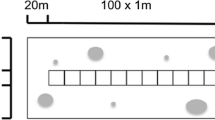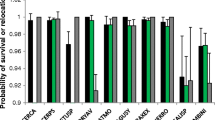Abstract
Seedling mortality in tree populations limits population growth rates and controls the diversity of forests. To learn about seedling mortality, ecologists use repeated censuses of forest quadrats to determine the number of tree seedlings that have survived from the previous census and to find new ones. Typically, newly found seedlings are marked with flags. But flagging is labor intensive and limits the spatial and temporal coverage of such studies. The alternative of not flagging has the advantage of ease but suffers from two main disadvantages. It complicates the analysis and loses information. The contributions of this article are (i) to introduce a method for using unflagged census data to learn about seedling mortality and (ii) to quantify the information loss so ecologists can make informed decisions about whether to flag. Based on presented results, we believe that not flagging is often the preferred alternative. The labor saved by not flagging can be used to better advantage in extending the coverage of the study.
Similar content being viewed by others
References
Beckage, B. (2000), “A Long-Term Study of Red Maple (Acer rubrum L.) Seedling Survival in Southern Appalachian Forests: The Effects of Canopy Gaps and Shrub Understories,” Ph.D. thesis, Duke University, Durham, NC.
Brown, L. D. (1986), Fundamentals of Statistical Exponential Families With Applications in Statistical Decision Theory, Hayward, CA: Institute of Mathematical Statisties.
Casella, G., and George, E. I. (1992), “Explaining the Gibbs Sampler,” The American Statistican, 46, 167–174.
Clark, J. S., and Beckage, B., and Camill, P., and Cleveland, B., and HilleRisLambers, J., Lichter, J., and MacLachlan, J., and Mohan, J., and Wyckoff, P. (1999), “Interpreting Recruitment Limitation in Forests,” American Journal of Botany, 86, 1–16.
Clark, J. S., and Macklin, E., and Wood, L. (1998), “Stages and Spatial Scales of Recruitment Limitation in Southern Appalachian Forests,” Ecological Monographs 68, 213–235.
Gelfand, A. E., and Smith, A. F. M. (1990), “Sampling Based Approaches to Calculating Marginal Densities,” Journal of the American Statistical Association, 85, 398–409.
Grubb, P. J. (1977), “The Maintenance of Species-Richness in Plant Communities: The Importance of the Regeneration Niche,” Biological Reviews, 52, 107–145.
Hubbell, S. P., and Foster, R. B., and O’Brien, S. T., and Harms, K. E., and Condit, R., Wechsler, B., and Wright, S. J., and de Lao, S. L. (1999), “Light-Gap Disfurbances, Recruitment Limitation, and Tree Diversity in a Neotropical Forest,” Science, 283, 554–557.
Jones, R., and Sharitz, R., and Dixon, P., and Segal, D., and Schneider, R. (1994), “Woody Plant Regeneration in Four Flood plain Forests,” Ecological Monographs, 64, 345–367.
Kahn, W. D. (1987), “A Cautionary Note for Bayesian Estimation of the Binomial Parameter n”, The American Statistician, 41, 38–39.
Lavine, M., and Wasserman, L. (1992), “Can We Estimate N?” Discussion Paper 92A-08, Institute of Statistics and Decision Sciences, Duke University, Durham, NC.
Pacala, S. W., and Tilman, D. (1994), “Limiting Similarity in Mechanistic and Spatial Models of Plant Competition in Heterogeneous Environments,” The American Naturalist, 143, 222–257.
Raftery, A. E. (1988), “Inference for the N Parameter: A Hierarchical Bayes Approach,” Biometrika, 75, 223–228.
Streng, D., and Glitzenstein, J., and Harcombe, P. (1989), “Woody Seedling Dynamics in an East Texas Flood plain Forest,” Ecological Monographis, 59, 177–204.
Sundberg, R. (1974), “Maximum Likelihood Theory for Incomplete Data From an Exponential Family,” Scandina vian Journal of Statistics, 1, 49–58.
Watt, A. S. (1947), “Pattern and Process in the Plant Community,” Journal of Ecology, 35, 1–22.
Author information
Authors and Affiliations
Corresponding author
Rights and permissions
About this article
Cite this article
Lavine, M., Beckage, B. & Clark, J.S. Statistical modeling of seedling mortality. JABES 7, 21–41 (2002). https://doi.org/10.1198/108571102317475044
Received:
Accepted:
Issue Date:
DOI: https://doi.org/10.1198/108571102317475044




